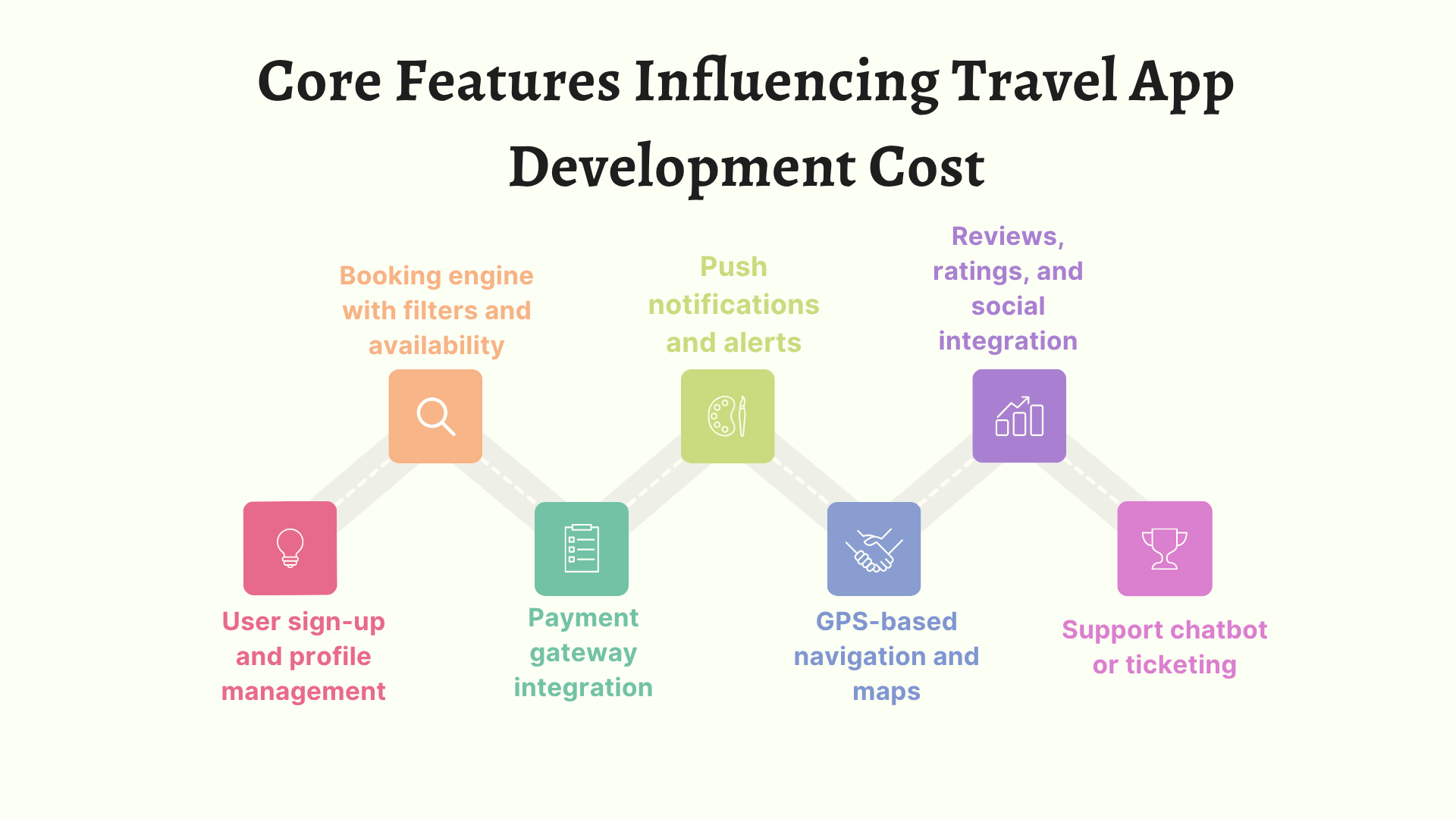As digital travel experiences become the norm, travel businesses are increasingly turning to mobile technology to engage users, streamline bookings, and personalize offerings. Understanding the travel app development cost is essential to launching a successful mobile solution in 2025.
From tourism boards and agencies to hotel chains and flight aggregators, investment in travel app development is growing steadily, and with good reason. However, the cost of developing a travel app can vary significantly based on the features, complexity, and geography of your development partner.
In this detailed breakdown, we’ll explore key pricing factors, region-based comparisons like travel app development cost USA vs India, cost-saving strategies, and insights to help you plan smartly. Whether you’re looking for a full product or just exploring an MVP development guide, we’ve got you covered.
Why Invest in a Travel App in 2025?

In 2025, the travel industry is leaning heavily on mobile-first experiences. With more travelers relying on mobile apps for trip planning, bookings, and real-time updates, the demand for high-quality travel mobile app development is at an all-time high. A smart, user-friendly app enhances brand loyalty, opens new revenue channels, and delivers hyper-personalized experiences that today’s travelers expect.
Types of Travel Apps & Their Impact on Cost:
Your choice of app category will shape your budget. Here’s a quick look at how different types of travel apps affect development cost:
Travel App Type | Description | Complexity & Cost Impact |
| Booking Apps | Flights, hotels, rental cars | Moderate to high |
| Itinerary Planners | Personal travel scheduling and plans | Moderate |
| Navigation & Local Guide | Maps, points of interest, AR integrations | Moderate to high |
| Aggregator Platforms | Combines multiple services/providers | High |
| Travel Marketplace Apps | B2C/B2B vendor onboarding and transactions | High |
Each model influences the scope, time, and technology stack, and thus the final travel app development pricing. For a deeper dive, refer to our travel app development guide that maps feature-to-cost alignment.
Core Features Influencing Travel App Development Cost:
The cost of building a travel app largely depends on the features you choose to include. Here are some essential functionalities that impact the overall budget:

- User sign-up and profile management
- Booking engine with filters and availability
- Payment gateway integration
- Push notifications and alerts
- GPS-based navigation and maps
- Reviews, ratings, and social integration
- Support chatbot or ticketing
Advanced features like AI recommendations, offline access, and AR-based city tours can raise your budget but enhance app engagement dramatically. Incorporating AI in Software Testing can also reduce long-term QA costs.
Travel App Development Cost Breakdown:
Let’s look at how geography and development models affect the cost:
Region | Hourly Rate | Estimated Cost (Full App) |
| USA | $100 – $180 | $100,000 – $250,000 |
| Eastern Europe | $40 – $75 | $40,000 – $90,000 |
| India | $20 – $45 | $20,000 – $60,000 |
The travel app development cost in USA is considerably higher than in regions like India. Opting for offshore talent allows businesses to create a minimum viable product (MVP) affordably while retaining quality. Choosing the right travel app development company is critical here.
Tech Stack & Third-Party Integrations:
A flexible and scalable tech stack is crucial for successful travel portal development:
- Frontend: React Native, Flutter, Swift (iOS), Kotlin (Android)
- Backend: Node.js, Ruby on Rails, Django
- Databases: PostgreSQL, Firebase, MongoDB
- APIs & Services: Skyscanner API, Amadeus, TripAdvisor, Stripe, Twilio
Ensure your stack complies with Cybersecurity Services to protect user and payment data.
Development Time & Cost Estimation:
The time and budget to develop a travel app depend largely on the app’s complexity, the level of UI/UX customization, the number of third-party integrations, and the development team’s location. A basic app may take 2–3 months, while a feature-rich solution with AI, AR/VR, and offline capabilities could extend the timeline beyond 8 months.
Using cross-platform tools like Flutter or React Native and an agile development approach can speed up delivery while ensuring flexibility. Accurate estimates aligned to your app tier help balance scope, cost, and timelines efficiently.
App Tier | Key Features | Estimated Cost | Timeline |
| Basic | Listings, Search, Booking | $20,000 – $30,000 | 2 – 3 months |
| Mid-Level | Reviews, Notifications, Maps, Payments | $40,000 – $80,000 | 3 – 5 months |
| Advanced | AI itineraries, Offline Access, AR/VR | $90,000 -$200,000+ | 5 – 8+months |
Efficient execution requires a robust mobile app development process and a DevOps in mobile app development to streamline development.
Factors Influencing Travel App Costs
Key variables that affect travel app development pricing include:
- App platform (iOS, Android, both)
- Custom UI/UX vs. ready-made templates
- Number of integrations (payment, booking engines, maps)
- Real-time syncing and offline features
- Security measures and compliance needs
Each added layer of functionality can impact your timeline and budget, making prioritization essential.
Hidden Costs to Consider
These often-overlooked elements can influence your budget:
- App store registration and maintenance fees
- Third-party service subscriptions
- Ongoing bug fixes and updates
- Post-launch marketing and ASO
- Load testing and AI-based software testing
Planning for these will help avoid budget overruns after launch.
Tips to Optimize Travel App Development Costs
Following a smart software product development cycle will help you remain adaptive and cost-efficient.
- Begin with a focused MVP to validate your core offering
- Use cross-platform frameworks to reduce development hours
- Leverage open-source or prebuilt components when applicable
- Partner with experienced teams in cost-effective regions
- Use agile sprints to build, test, and improve iteratively
How to Choose the Right Development Partner
The ideal partner should:
- Offer end-to-end expertise (strategy to support)
- Have relevant domain experience in travel application development
- Provide scalable engagement models
- Emphasize security and compliance
- Demonstrate success with recent case studies
A collaborative partner who understands your growth goals will help you scale faster. Make sure to verify if your shortlisted app development company has case studies relevant to the travel or hospitality domain.
Why Choose Sparx IT Solutions?
Sparx IT Solutions combines industry knowledge with technical expertise to deliver reliable and high-performing travel apps. We focus on creating secure, scalable, and user-friendly mobile experiences tailored to your needs. From concept to launch, our agile team ensures timely delivery, optimized costs, and future-ready solutions that keep you ahead in a fast-moving market.
Final Thoughts
Understanding travel app development cost in 2025 helps stakeholders make informed decisions, balance priorities, and maximize ROI. Whether you’re building a booking app, itinerary planner, or full-fledged travel marketplace, planning with realistic cost insights sets you up for long-term success.

Partner with Experts
Frequently Asked Questions
What is the average travel app development cost in 2025?









Between $20,000 and $200,000+, depending on features, region, and tech stack.
What’s the most cost-effective way to build a travel app?
















Build a cross-platform MVP with an Indian or Eastern European team and iterate.
What’s the difference between a travel app and a travel portal?
















A portal includes web + mobile + dashboards, while an app may be mobile-only.
Is tourism app development still a good investment in 2025?
















Yes. With digital bookings surging and Gen Z travelers going mobile-first, the demand is strong.
What factors influence the timeline for travel app development?
















Timeline depends on app complexity, team size, feature set, platform choice, and project methodology (agile or waterfall).
What role does cybersecurity play in travel app development?
















A major one. Secure payment handling, user data protection, and compliance with local laws require attention to strong cybersecurity parameters.
How can I reduce my travel portal development cost without cutting quality?
















Use open-source modules, prioritize features for your MVP, and choose a region with favorable hourly rates, such as India or Eastern Europe.



